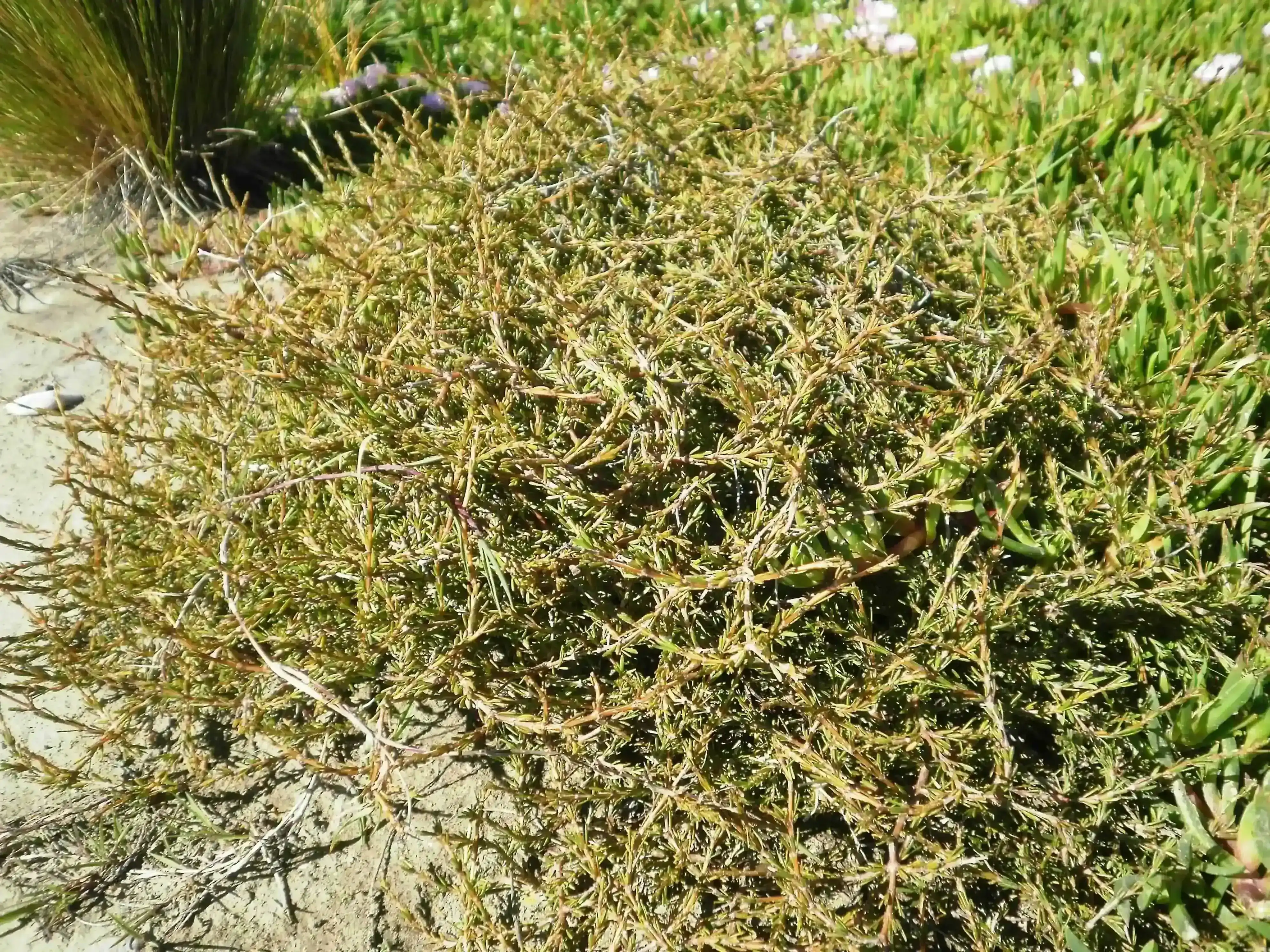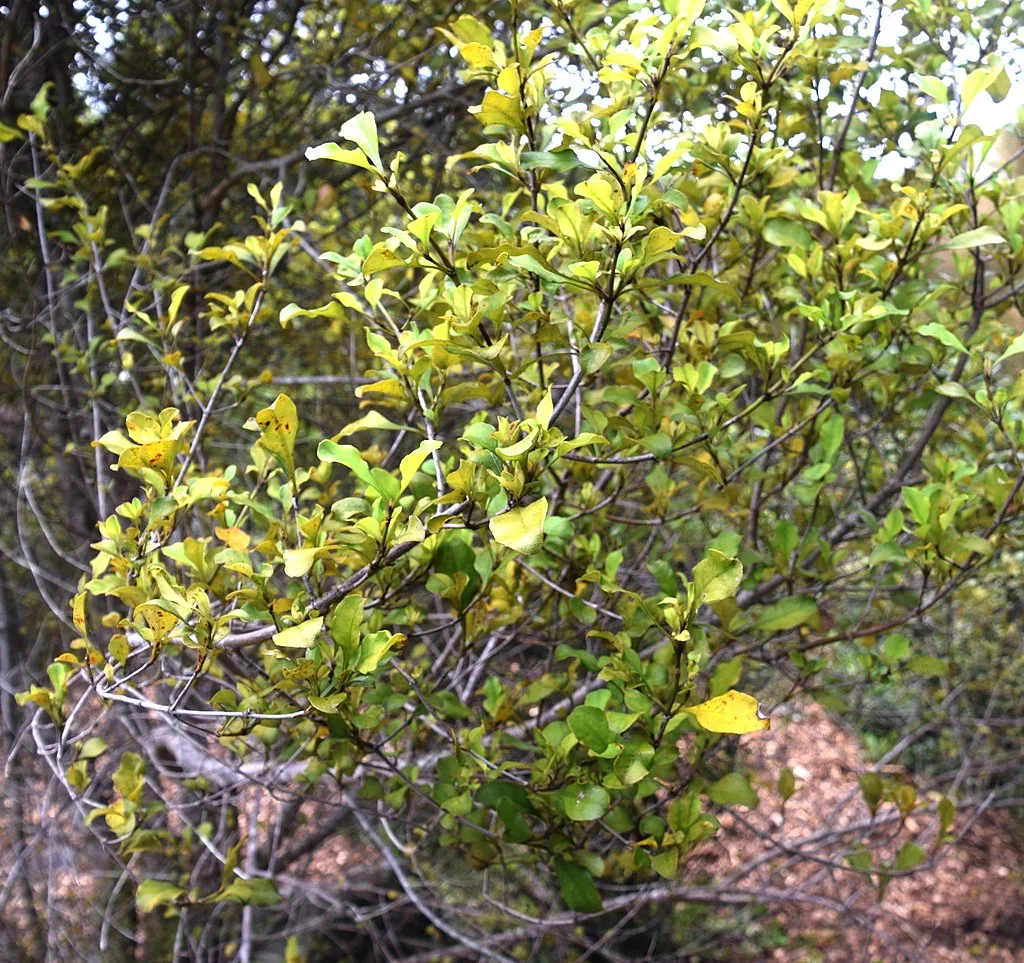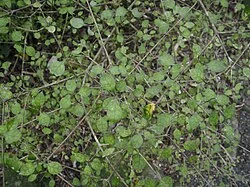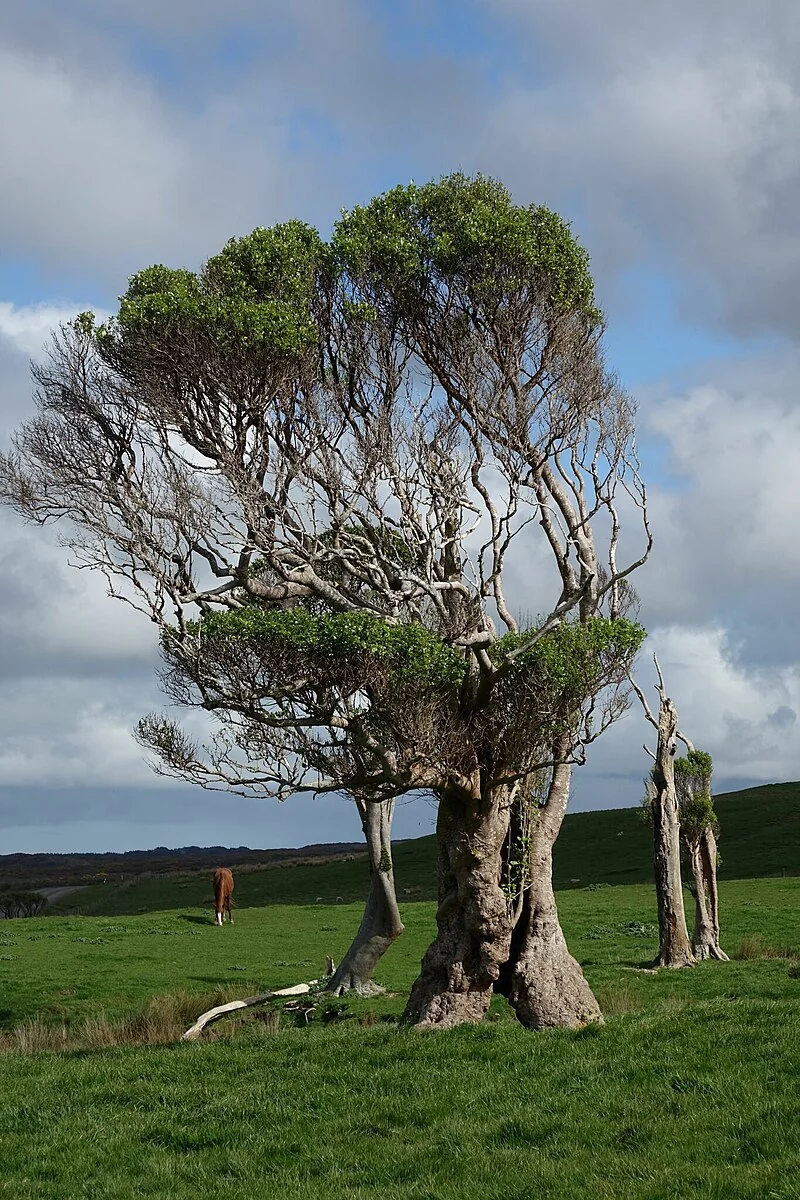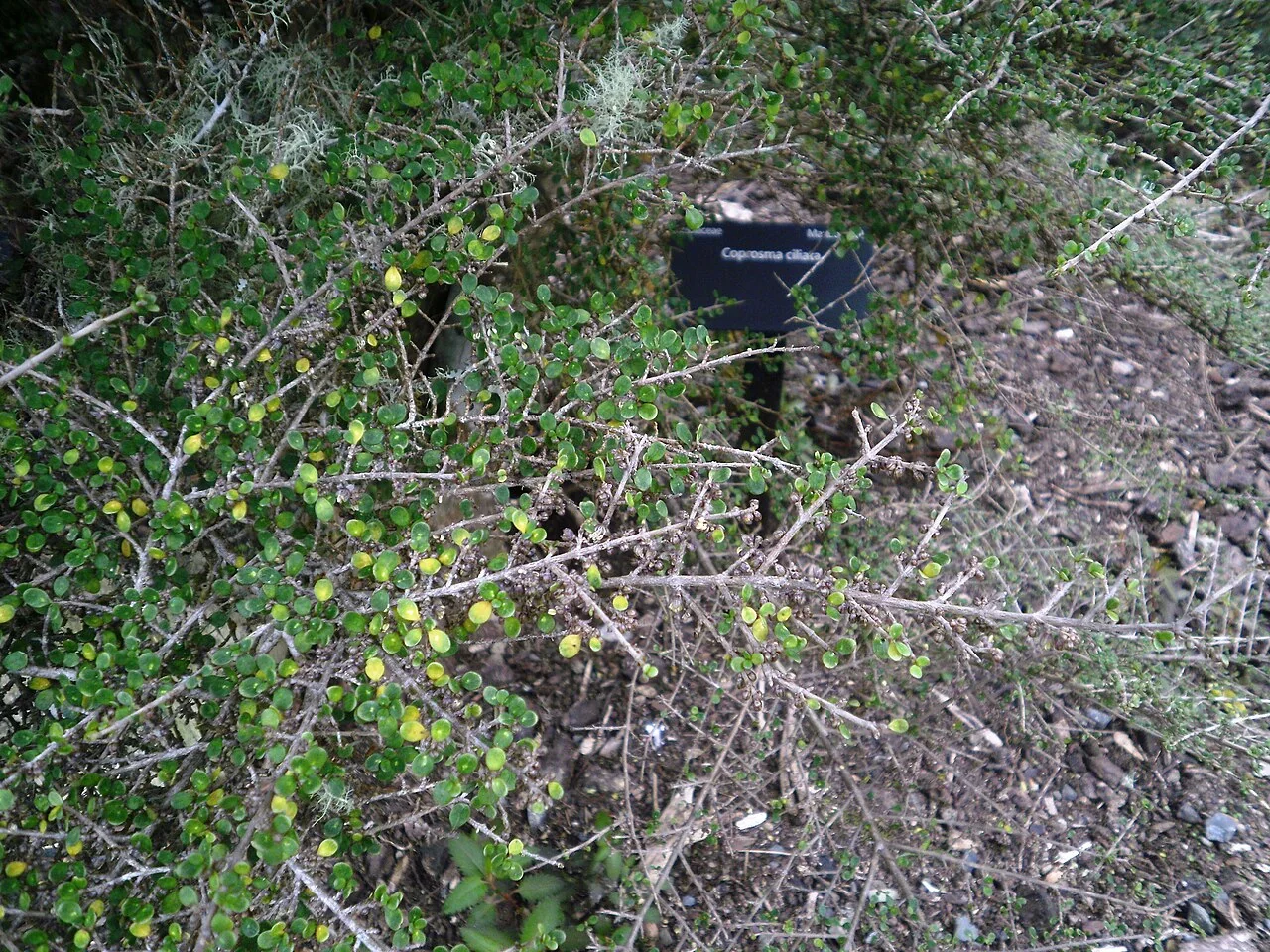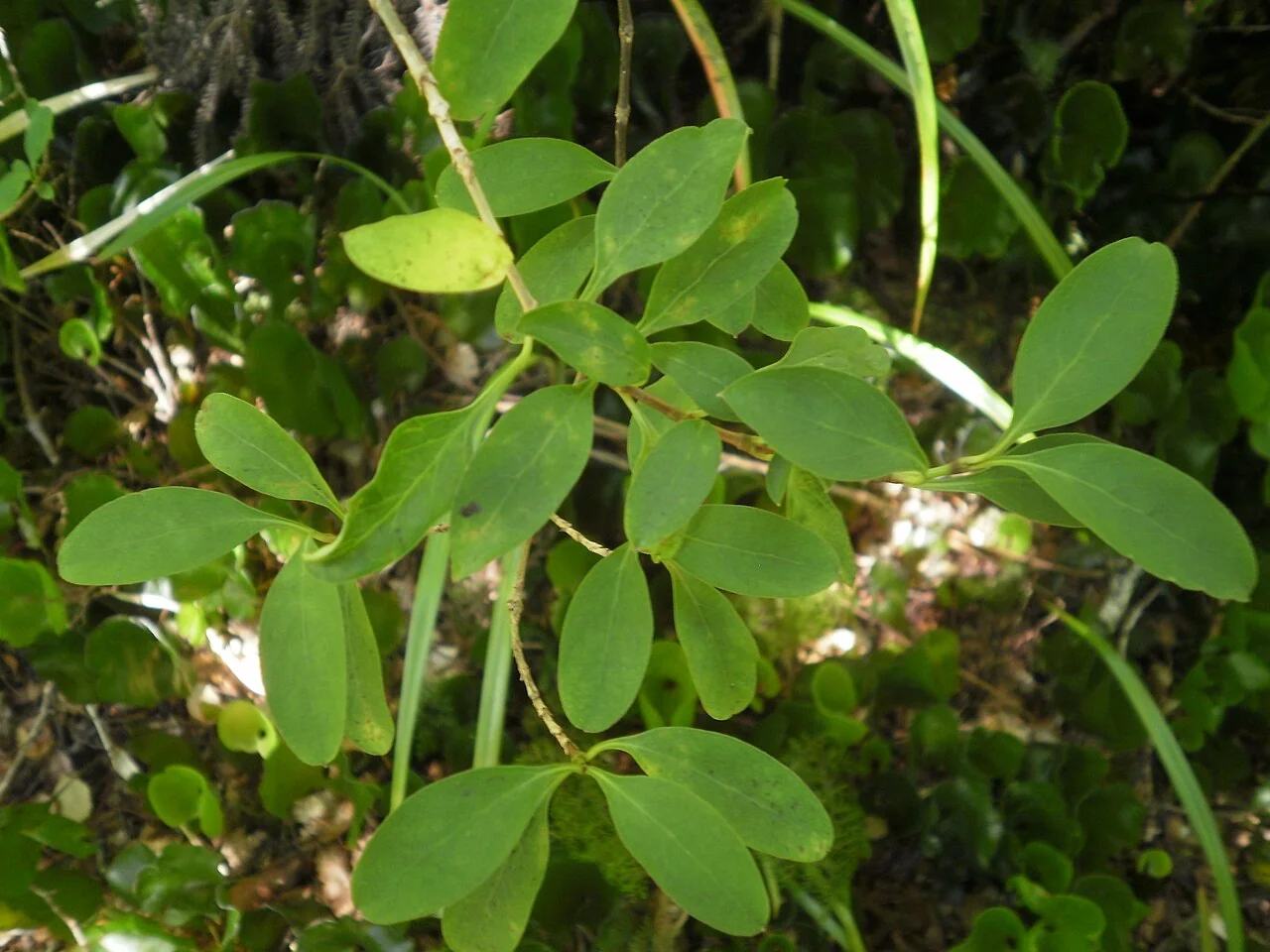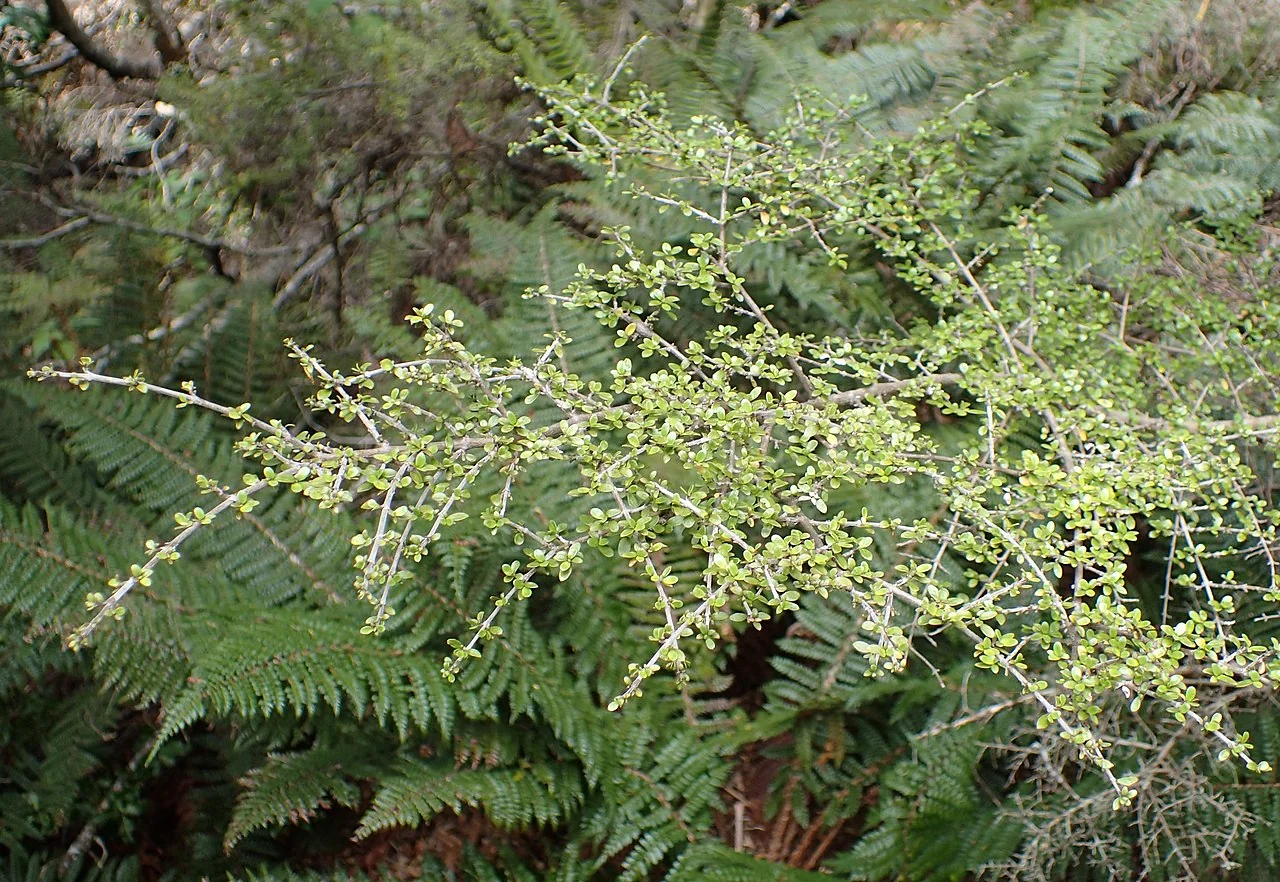
Broad-Leaved Coprosma
Coprosma dumosa
Coprosma dumosa is a species among New Zealand's native shrubs endemic to New Zealand, commonly found in higher rainfall montane forests and shrublands from the Kaimai Range southwards to Stewart Island, and also in drier parts of the South Island. It is an erect shrub that can grow up to 3 meters tall, with a leafy appearance and slender, robust branches that have smooth, grey to grey-brown bark. The leaves are small, elliptic to obovate, 4-13 mm long and 2-6 mm wide, pale grey-green to yellow-green, and grow in clusters of pairs on short branchlets. They are thick, with 1-2 pits on the underside, and the main vein reaches the leaf tip. The fruit is a spherical drupe, 4-5 mm in diameter, on a short stalk. The fruit can be transparent white, pale gold, pale pink, or bright red, with two seeds per drupe. In the North Island, fruits are mostly white/translucent, while in other areas they can be orange or red.

Plant Description
Botanical Features
Coprosma dumosa , commonly known as Broad-leaved Coprosma, is an erect, bushy shrub endemic to New Zealand, typically growing up to 3 meters tall. It is characterized by its slender, robust branches with smooth, grey to grey-brown bark. The leaves are small, elliptic to obovate, 4-13 mm long and 2-6 mm wide, pale grey-green to yellow-green, and grow in clusters of pairs on short branchlets. They are thick, with 1-2 pits on the underside, and the main vein reaches the leaf tip. The fruit is a spherical drupe, 4-5 mm in diameter, which can be transparent white, pale gold, pale pink, or bright red, ripening between February and April. This hardy shrub is found in higher rainfall montane forests and shrublands from the Kaimai Range southwards to Stewart Island, and also in drier parts of the South Island.
Quick Facts
| Scientific Name | Coprosma Dumosa |
|---|---|
| Height | 1-3 m |
| Spread | 2-4 m |
| Water Needs | Low to moderate |
| Light | Full sun to part shade |
| Frost Tolerance | Good |
| Salt Tolerance | Moderate |
| Growth Rate | Moderate |
| Lifespan | Long |
Climate Best Suited to
White maire (Nestegis lanceolata) is primarily found in lowland to hilly forests across the North Island of New Zealand, extending to the Marlborough Sounds in the South Island. It demonstrates good adaptability to various conditions, thriving in areas with well-drained soils and tolerating both full sun and partial shade. Its natural distribution suggests a preference for warmer, more humid environments but with a reasonable tolerance for cooler temperatures found in its southern range.
Regional Suitability
| Whangārei | Ideal |
| Auckland | Ideal |
| Hamilton | Suitable |
| Rotorua | Suitable |
| Tauranga | Ideal |
| Gisborne | Ideal |
| New Plymouth | Ideal |
| Whanganui | Ideal |
| Palmerston North | Suitable |
| Napier | Ideal |
| Wellington | Ideal |
| Nelson | Ideal |
| Christchurch | Suitable |
| Dunedin | Suitable |
| Invercargill | Suitable |
| City | Climate Suitability |
|---|
Habitat
Natural Distribution
Coprosma dumosa is an erect shrub species endemic to New Zealand, found across various regions from the North Island (south of the Kaimai Range) to the South Island and Stewart Island. It thrives in environments ranging from lowland forests to montane and sub-alpine scrub zones, typically at elevations starting around 1100 m.
This species is commonly found in higher rainfall montane forests and shrublands. It is most abundant on valley floors and in stream gullies, where it benefits from moist conditions. While considered rare in the northern parts of New Zealand, its prevalence increases further south, being very common in many regions of the South Island, though relatively rare in Fiordland. It can also be found growing on the slopes of Mt. Taranaki. Coprosma dumosa is also present in drier parts of the South Island.
Plant Conservation
Coprosma dumosa is classified as "Not Threatened" under the New Zealand Threat Classification System (NZTCS). This status has been consistently reported in assessments of New Zealand indigenous vascular plants, including those from 2012, 2017, and 2023. It is an endemic taxon to New Zealand, found on the North, South, and Stewart Islands.
Growing Requirements
Soil Requirements
White maire (Nestegis lanceolata) is remarkably adaptable to different soil conditions, thriving in well-drained environments. It can tolerate a variety of soil types, from sandy to loamy, and prefers a neutral to slightly acidic pH. Good drainage is crucial to prevent root rot, ensuring healthy growth and development.
- Tolerates a wide range of soil types from clay to sandy
- Prefers well-draining soils but can handle occasional waterlogging
- Thrives in moderately fertile soils but will grow in poor soils too
- Can tolerate slightly acidic to slightly alkaline pH
- Handles coastal conditions including salt spray
Light Requirements
White maire (Nestegis lanceolata) thrives in a variety of light conditions, from full sun to partial shade. Optimal growth and flowering are typically achieved in locations receiving ample sunlight throughout the day. However, it can also tolerate some shade, especially in hotter climates, where it benefits from protection during the most intense afternoon sun.
- Full sun for optimal growth and form
- Can tolerate partial shade but may develop a leggier form
- At least 6 hours of direct sunlight daily is ideal
- Northern or eastern exposures work well in garden settings
Water Requirements
Once established, White maire (Nestegis lanceolata) is remarkably drought-tolerant, requiring minimal supplemental watering. During its establishment phase, consistent moisture is crucial to encourage strong root development. Mature plants can withstand dry periods, but regular watering during prolonged droughts will promote healthier growth and more abundant flowering.
- Moderate watering during establishment (first 1-2 years)
- Drought-tolerant once established
- Can handle periods of soil saturation
- Reduce watering in winter when growth slows
- Signs of overwatering include yellowing leaves and crown rot
Planting Guide
How to Plant
When planting Coprosma dumosa , choose a sunny position with well-drained soil. Enrich the soil with organic plant food to provide a good start. Dig a planting hole that is twice as wide and to the same depth as the root-ball. Gently tease the roots before planting to encourage outward growth. Position the plant so the top of the roots are level with the surrounding ground, then backfill with soil and gently firm it down.
After Planting Care
Water deeply after planting to settle the soil around the roots. Keep the soil moist for several weeks until the plant establishes. Once established, Coprosma dumosa is drought-tolerant and requires very little watering, though consistent moisture during prolonged dry periods is beneficial. Mulch around the base with organic material, keeping it away from the plant's stem, to help retain soil moisture and suppress weeds.
Ecological Significance
Coprosma dumosa plays a vital role in New Zealand's ecosystems. It serves as an important food source for native birds and bees, contributing to the biodiversity and health of local fauna. Its adaptability to various environments, from lowland forests to sub-alpine scrub zones, makes it a key component in diverse native plant communities.
This species is often utilized in forest restoration, hedging, and riparian plantings, helping to stabilize soil and provide habitat. Notably, the mistletoe Korthalsella clavata uses Coprosma dumosa as a secondary host, highlighting its interconnectedness within the native flora. Currently, Coprosma dumosa is classified as "Not Threatened" in New Zealand, indicating a stable population within its natural range.
Uses and Significance
Garden Uses
- Specimen tree for visual impact
- Suitable for native gardens and restoration projects
- Enhances native garden aesthetics and biodiversity
- Provides architectural accent with its unique structure
- Effective for erosion control on slopes and banks
Ecological Value
Ecologically, White maire (Nestegis lanceolata) plays a crucial role in supporting native ecosystems. Its fruits are a food source for birds, especially the kererū, contributing to the local biodiversity and food web.
- Provides a vital food source for native birds, especially the kererū
- Offers habitat and nesting sites for various fauna
- Contributes to soil stabilization and nutrient cycling
- Forms natural shelter belts, protecting other species
Cultural Significance
Traditional Uses and Values
Broad-leaved Coprosma ( Coprosma dumosa ) holds cultural significance as part of the diverse Coprosma family, many species of which were traditionally used by Māori for various purposes, including medicinal applications (rongoā) and as food sources. Its presence in forest ecosystems also contributes to traditional ecological knowledge, highlighting the interconnectedness of native flora and fauna.
Landscaping Uses
Garden Design Applications
Coprosma dumosa is a versatile native shrub that can be effectively incorporated into various landscaping designs in New Zealand. Its bushy habit and tolerance to different conditions make it suitable for a range of applications.
- Bird and Bee Attractant: The plant's berries and flowers provide a valuable food source, attracting native birds and bees to your garden.
- Forest and Riparian Plantings: Ideal for ecological restoration projects, especially in forest and riverside areas, where it helps stabilize soil and contributes to natural habitat.
- Hedging: Can be used for informal hedging, providing a natural and dense screen.
- Specimen Plant: Its unique form and seasonal berries can make it an attractive specimen plant in a native garden.
- Container Planting: Younger plants can be grown in containers on patios or balconies.
- Coastal Gardens: Its wind and salt tolerance make it a good choice for coastal areas.
Seasonal Care Calendar
Spring
In spring, White maire (Nestegis lanceolata) begins its active growth phase. New foliage emerges, and it's an ideal time for planting new specimens or propagating. Ensure adequate moisture and monitor for early signs of pests.
- New growth begins with fresh foliage development
- Apply a balanced, slow-release fertilizer if desired
- Excellent time for planting new specimens or dividing offsets
- Monitor for new pest activity and address promptly
Summer
Summer is the peak growing season for White maire (Nestegis lanceolata), often accompanied by flowering. Consistent watering is important, especially for young plants, to support vigorous growth and prevent stress during dry periods.
- Flowering typically occurs in early to mid-summer (November-January)
- Water young trees regularly during extended dry periods
- Avoid heavy pruning during the active growing season
Autumn
During autumn, White maire (Nestegis lanceolata) prepares for the cooler months. Fruits or berries develop, providing food for native birds. It's also a good time for planting and general garden cleanup.
- Fruits or berries develop and ripen (December-February), attracting birds
- Natural leaf shedding occurs as part of its growth cycle
- Good time for planting new specimens to establish before winter
- Clean up fallen leaves if a tidy appearance is desired
Winter
Winter is generally a dormant period for White maire (Nestegis lanceolata). Minimal care is required, though young plants may benefit from protection in colder regions. This is an opportune time for any necessary structural pruning.
- Generally dormant with minimal growth activity
- No special winter protection needed in most mild climates
- Suitable time for structural pruning if required
- Fallen leaves can be left as mulch or removed for tidiness
When to Prune and How Much
White maire (Nestegis lanceolata) generally requires minimal pruning to maintain its natural form and health. Pruning should focus on removing dead or damaged growth and shaping the plant as needed.
- Remove dead, damaged, or diseased branches at any time of year
- Light formative pruning when young helps establish good structure
- To create a multi-trunked specimen, cut the main stem to encourage branching
- Fallen leaves can be removed for a tidier appearance, or left as natural mulch
- If necessary, lower branches can be removed to create clearance underneath
- Major pruning is best done in late winter to early spring before new growth
Always use clean, sharp tools for pruning to minimize the risk of disease and ensure clean cuts. The plant often responds well to pruning with vigorous new growth, contributing to a fuller, healthier appearance.
How to Grow Broad-Leaved Coprosma
From Fresh Seeds
Fresh seed propagation represents the most reliable and straightforward method for growing Broad-leaved Coprosma, taking advantage of this versatile shrub's excellent seed production and natural adaptability that has allowed it to thrive across diverse New Zealand environments from the Kaimai Range to Stewart Island. This hardy endemic produces abundant spherical drupes in various colours including orange, red, white, and translucent fruits that provide exceptional opportunities for propagation while supporting natural frugivory dispersal cycles essential for ecosystem function. The species' adaptation to both higher rainfall montane forests and drier South Island environments makes it particularly valuable for diverse restoration projects and native gardens requiring resilient plants capable of handling variable growing conditions. Fresh seeds yield significantly higher germination success compared to stored seeds, making immediate processing and sowing the preferred approach for both conservation propagation and commercial nursery production of this ecologically important shrub. Collect ripe berries during February to April when fruits have achieved their characteristic coloration and can be easily removed from layered branches, timing collection to coincide with peak ripeness when seeds have reached maximum viability. Choose fruits that are fully developed, firm, and show their distinctive colorations whether orange, red, white, or translucent, avoiding any that appear damaged, diseased, or prematurely dropped which might indicate compromised seed quality. Process berries immediately after collection by removing all flesh through thorough washing, using gentle rubbing under running water to separate seeds from fruit material that could inhibit germination or promote fungal growth during establishment. Clean seeds by repeated washing until all fruit debris is removed, retaining the small seeds that settle to the bottom while discarding floating material that typically indicates poor viability or damaged genetic material. Prepare optimal germination medium using well-draining seed-raising mix with good moisture retention characteristics, ensuring pH levels between 6.0-7.0 that support healthy development for this adaptable forest understory species. Sow fresh seeds immediately after processing, placing them on the surface of moist growing medium or covering lightly with 2-3mm of fine sand, as they benefit from some light exposure during germination while requiring protection from drying out. Provide optimal environmental conditions including consistent temperatures between 15-20°C and bright, indirect light that replicates the filtered forest conditions where this species naturally establishes in diverse woodland environments. Maintain careful moisture management throughout the 4-8 week germination period, ensuring growing medium remains consistently moist but never waterlogged while monitoring for early emergence signs. Young seedlings develop at moderate rates while establishing the root systems necessary for adaptation to diverse growing conditions, requiring protection from direct sunlight and environmental stress during early establishment phases. Transplant successful seedlings when they reach 3-5cm height and have developed sufficient root systems to handle garden conditions, providing growing environments that support transition from nursery to permanent landscape locations where they can contribute to native plant communities. This easy propagation method makes Broad-leaved Coprosma an excellent choice for gardeners seeking reliable results with native plant cultivation while contributing to conservation efforts through expanding populations of this ecologically valuable species.
From Semi-Hardwood Cuttings
Semi-hardwood cutting propagation offers an excellent vegetative method for growing Broad-leaved Coprosma that preserves the exact genetic characteristics of superior parent plants while providing reliable results for both experienced propagators and beginners working with native plant cultivation. This approach is particularly valuable for maintaining exceptional specimens that demonstrate superior adaptation to specific growing conditions, enhanced growth habits, or other desirable traits that can be preserved through careful vegetative propagation techniques. The method works especially well with Broad-leaved Coprosma because of this species' natural ability to develop adventitious roots under appropriate growing conditions, making it suitable for both commercial nursery production and home gardening applications. Take semi-hardwood cuttings during late summer to early autumn when current season's growth has achieved optimal maturity for rooting while retaining sufficient vigor for successful establishment under controlled propagation environments. Select healthy, vigorous shoots from the middle portions of layered branches that display the characteristic small elliptical leaves and robust growth typical of healthy Broad-leaved Coprosma development, avoiding both very soft growth and completely hardened wood that may resist rooting. Cut sections 8-12cm in length with clean, sharp secateurs, ensuring each cutting includes at least 2-3 nodes while selecting material that represents the best characteristics of the parent plant including compact growth habit and healthy foliage development. Remove lower leaves carefully to reduce transpiration stress while retaining sufficient photosynthetic capacity in upper leaves, taking care not to damage the small elliptical leaves that provide energy for root development during the establishment period. Apply rooting hormone powder or solution immediately after preparation, using formulations appropriate for semi-hardwood native species to enhance root initiation while ensuring even coverage of cut surfaces where new root systems will develop. Insert prepared cuttings into well-draining cutting mix composed of equal parts quality propagation medium and coarse sand or perlite, ensuring excellent drainage while maintaining the consistent moisture levels essential for successful root development without creating waterlogged conditions. Maintain optimal environmental conditions including high humidity (75-85%) and consistent temperatures around 18-20°C using humidity domes, misting systems, or controlled environment facilities that support root development while preventing cutting stress. Provide bright, indirect light that supports photosynthesis without causing excessive transpiration stress, replicating the filtered light conditions where this species naturally thrives in forest understory environments from lowland to montane elevations. Monitor cutting development throughout the 6-10 week rooting period, maintaining consistent environmental conditions while watching for signs of successful root development including new shoot growth and resistance when gently tested. Root development occurs gradually as cuttings establish the fibrous root systems characteristic of mature Broad-leaved Coprosma plants, requiring patience and consistent care throughout the establishment process. This method provides excellent results for maintaining specific genetic lines while contributing to conservation efforts that preserve the natural variation essential for healthy native plant populations in restoration and landscape applications, making it an ideal choice for gardeners seeking to propagate superior forms of this valuable native shrub.
From Shaded Site Cultivation
Shaded site cultivation provides an optimal growing approach for Broad-leaved Coprosma that replicates the natural forest understory conditions where this species thrives while taking advantage of its preference for deep, moist soils and filtered light environments. This method is particularly effective because it recognizes the species' natural adaptation to growing beneath forest canopies where it forms important components of native plant communities from lowland to montane elevations. Understanding and providing these preferred growing conditions leads to superior establishment success and long-term plant health compared to attempting cultivation in full sun or dry conditions that stress this naturally shade-tolerant species. Begin by selecting appropriate shaded locations that provide the filtered light conditions typical of forest understory environments, including positions under established trees, on the protected side of buildings, or in naturally sheltered garden areas that receive bright indirect light throughout most of the day. Ensure selected sites offer protection from harsh afternoon sun, drying winds, and extreme temperature fluctuations that can stress plants adapted to the stable microclimate conditions found in natural forest environments. Prepare optimal growing sites by incorporating substantial amounts of organic matter into the soil to create the deep, moist conditions that this species requires for healthy root development and sustained growth throughout variable weather conditions. Improve soil structure and moisture retention through addition of compost, well-rotted leaf mold, or other organic amendments that replicate the rich, humus-filled soils characteristic of natural forest floors where this species naturally establishes. Establish plants during optimal planting windows in autumn or spring when environmental conditions support rapid establishment before plants face stress from summer heat or winter cold that can challenge even hardy native species during vulnerable establishment phases. Space plantings according to mature size expectations while considering the layered branching habit that gives this species its distinctive appearance, allowing adequate room for natural development while creating attractive groupings that reflect natural forest understory patterns. Provide consistent moisture management throughout the establishment period by maintaining soil moisture without waterlogging, using mulching techniques that conserve soil moisture while suppressing weed competition that can interfere with young plant development. Monitor plant development carefully during the first growing season, adjusting watering, mulching, and protection as needed to ensure successful establishment in cultivation conditions that support long-term growth and health. Create diverse garden environments by combining Broad-leaved Coprosma with appropriate companion species that naturally occur in similar forest understory conditions, developing authentic native plant communities that provide enhanced wildlife habitat and aesthetic appeal. Allow natural growth patterns to develop while providing minimal intervention beyond basic care requirements, as this species maintains excellent form when grown under appropriate shaded conditions that match its evolutionary preferences. This approach maximizes success rates while creating sustainable garden environments that support the ecological functions this species provides in authentic New Zealand forest ecosystems, making it an ideal choice for gardeners seeking to create naturalistic plantings that require minimal ongoing maintenance once properly established in suitable shaded locations.
Pests and Diseases
While Coprosma dumosa is generally considered a hardy native shrub, it can be susceptible to certain pests and diseases common to Coprosma species in New Zealand.
Common Pests
- Scale insects and aphids: These are common sap-sucking insects that can occasionally affect Coprosma plants.
- Thrips: These tiny insects can damage leaves, flowers, and fruits by sucking juices, potentially leading to leaf dieback.
- Coprosma white erineum mite ( Phyllocoptes coprosmae ): This endemic gall mite causes white, hairy growths (erineum) on the underside of leaves and can result in yellow (chlorotic) spots on the upper leaf surface.
Potential Diseases
- Fungal diseases: Powdery mildew can occur, especially in humid conditions.
- Leaf spots: Common on New Zealand Coprosma species, often attributed to Mycosphaerella coacervata (or its anamorph, Phyllosticta coprosmae ), which causes purple blotches and necrotic patches on leaves.
- Rust: Can manifest as pale yellow, circular, or irregular spots on the underside of leaves, which then turn yellow on the upper surface and eventually brown. This affects Karamā and other Coprosma species.
- Phytoplasma (" Candidatus Phytoplasma australiense "): Associated with "Coprosma lethal decline" in related species like Coprosma robusta . Symptoms include interveinal chlorosis, abnormal leaf yellowing or reddening, slowed growth, and shoot dieback. This phytoplasma could potentially affect Coprosma dumosa as well.
Bonus Tip
Expert Growing Advice
Broad-leaved Coprosma ( Coprosma dumosa ) is an excellent choice for planting in areas with variable moisture, such as along stream gullies or in higher rainfall montane forests. Its adaptability to both wet and drier conditions, combined with its role as a food source for native birds and bees, makes it a valuable addition to ecological restoration projects and native gardens seeking to enhance biodiversity.
